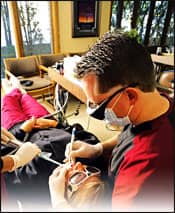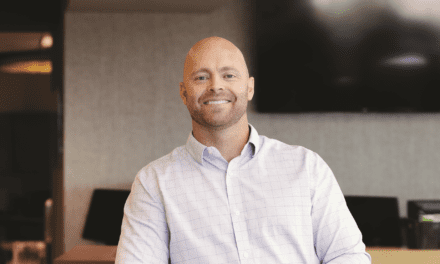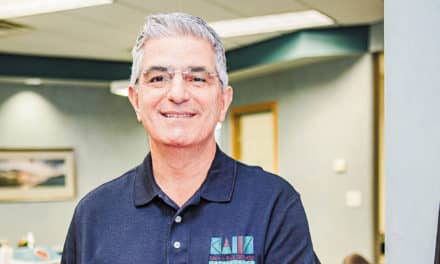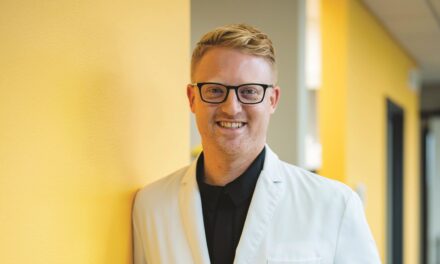by Rich Smith
Scott G. Smoron, DDS, MSD, uses high-tech tools to rebuild the practice he inherited from his father

The risk of making an unnecessary equipment purchase rises in direct proportion to the sexiness of the item under consideration.
Scott G. Smoron, DDS, MSD, accepts that as an immutable law of business. So, to protect against missteps, the Mt Prospect, Ill, orthodontist has disciplined himself to allow a year or more to pass before committing to buy any alluring, big-ticket item that pops up on his radar.
“When I decide I want something, I will write that item down in my organizer; if I still feel the same way about the product a year or even 2 years later as I did when I first decided it was a must-have for my practice, then I’ll go ahead and acquire it,” he says. “I like to wait before buying in order to give my emotions a chance to cool off. Then I can purchase with the confidence that I’m not going to end up with a toy that I’ll soon lose interest in.”
He Saw the Light
Hewing to the credo of “buy in haste, repent at leisure” has spared Smoron from needless choices on a number of occasions, resulting in a healthier practice overall. And with the capital saved by avoiding impulse buys, Smoron has been able to afford several truly valuable additions to his armamentarium, such as a Zap soft-tissue laser.
“I wanted a laser for several years,” he says. “The longer I waited to be certain it would become a regular part of my practice, the more reasons I saw for needing it.
“My particular reason for wanting it was to be able to have a less invasive, more easily tolerated way of dealing with those occasional canines that get stuck under soft tissue and take 6 months to poke through. Before the laser, there were only two courses. One was to just wait and waste clinical time and expense. The other was to suggest the patient see an oral surgeon to have that tooth uncovered. But oral surgery involves extra expense as well as considerable postoperative discomfort.
“With the laser, I knew I’d be able to get that tooth moving right away without surgery. A couple of nice things about the laser is it subjects the patient to only minor discomfort and it’s appreciably less expensive than oral surgery. That makes you look like a hero to parents. Also, I usually don’t charge separately for the laser. It doesn’t seem right to charge extra for using the laser if you are saving time and money and have committed to a fee. I’ve tried to make it a hallmark of my practice that, once the fee is set, that’s where it stays, no matter if treatment runs longer than planned or if we have to adjust the treatment plan. It’s just good business to stick with your word. The additional revenue missed really would not make the difference between practice success or failure.”
PRACTICE PROFILE
Name: Smiles by Smoron
Location: Mt Prospect, Ill
Owner: Scott Smoron, DDS, MSD
Specialty: Orthodontics
Years in practice: 7
Patients per day: 40
Starts per year: 200
Days worked per week: 4.5
Office square footage: 2,100
Uncovering teeth is not the laser’s only application. Smoron finds it useful too for evening up gum lines after braces are removed. “I always do enameloplasty and things don’t look quite finished when the gum levels are at different heights, so, with permission of the patient or parent, I use the laser to remedy that,” he explains.
Pricewise, orthodontic lasers start out at around $6,000 for a system designed to cut soft tissue, climbing to upward of $100,000 for a hydrodynamic version capable of making incisions through teeth and bone. Smoron says he spent $7,000 for his. “I could have spent way more and gotten more power and performance, but after carefully weighing the features against my practice’s needs, I realized that the lower-cost laser was perfect,” he says.
Smoron also found the laser a smart addition because it allowed him to better care for patients with implants. “Because tissues surrounding an implant sometimes become slightly inflamed, the laser provides a very efficient and effective way to deal with the problem,” Smoron says.
Bypassing Compliance
Opportunities to use implants crop up with some regularity in Smoron’s practice. “They’re great for those malocclusions that defy easy or conventional solution,” he says. “An example would be the open-bite situation where you’d like to be able to intrude some posterior teeth without having to resort to jaw surgery. Another example would be where the upper incisors are supererupted. Implants offer a good way to reintrude those teeth back to where they’re supposed to be. And for patients who are missing some teeth, implants work as excellent anchor points that you can place just about anywhere you choose in order to gain optimal control.”
- Smoron uses a soft-tissue laser to save his patients the cost and discomfort of oral surgery.
Implants, Smoron points out, are particularly beneficial for older adults who otherwise would be compelled to wear headgear in order to resolve some of these malocclusions. “Headgear may be fine for a 10-year-old, but you’re going to have all kinds of compliance issues if you tell a 35-year-old business executive that he or she is going to have to wear it,” he says. “With implants, you completely avoid that.”
Another technology to find its way into Smoron’s office after an extended period of contemplation was distalizers. “I think the CarriÈre distalizer is a brilliant idea,” he enthuses. “It utilizes simple biomechanical principles to provide a rotation movement of the maxillary first molars around their palatal root and, at the same time, give it a distalization vector. Typically, the CarriÈre distalizer features a two-piece design consisting of a socketed posterior pad and an interior rod with a ball on one end and, at the other, a pad with a hook on top. I find this very easy to work with, very hygienic. It lets me correct malocclusions that normally would require a Herbst appliance—and I can do so without nearly the inconvenience to the patient. That’s important because it allows me to focus on patient compliance with rubber-band wear at the beginning of treatment, which then frees me to concentrate on getting the teeth into their final place at the end of treatment. I’ve found that patients tend to become burned out on treatment by the 1-year point, so it’s a lot easier to get that compliance from them in the early stage of treatment rather than toward the end.”
Like Father, Like Son
Smoron’s father was an orthodontist. The way Smoron practices today is to some degree a continuation of the way his father practiced. As a matter of fact, his father’s practice is now his practice, period. The handoff began shortly before the younger Smoron completed orthodontic residency in 2000 at St Louis University (which followed dental school at Northwestern University and undergraduate studies at Notre Dame). “I received a call from one of my dad’s longtime friends, telling me I had to come home right away and step in to save the practice—my dad had developed Parkinson’s disease and was having increasing difficulty working,” Smoron recounts. By the time of that notification, the practice had evaporated to about a third of where it stood before Smoron’s father took ill.
With nearly a year of his residency still to go, Smoron commuted back to Mt Prospect every weekend. “The staff worked it so that the difficult procedures, critical decisions, and patients nearing completion were scheduled for Saturdays. Sometimes we would treat an entire week’s worth of his patients on that one day.”
Not until his residency was completed could Smoron devote himself to the task of rebuilding the practice. “Prior to that point, the best I could do was hold everything together,” he says. “By the time I could move back, he was ready to retire.” Things were in decline and staff were laid off before things picked up again. “It was basically nose to the grindstone: Do good things for people and hope for a recovery.”
Gradually, referrals picked up. Today, the practice is taking in approximately four times the revenues it generated just before Smoron’s father retired.
Smoron was able to confidently grab the baton and run with it for a variety of reasons, but one of the most basic was that he already possessed detailed familiarity with his father’s practice and patients. “I practically grew up in this office, even though I didn’t plan to become an orthodontist,” says Smoron, who had intended to become a chemical engineer and for a brief time worked as a computer consultant. “When I was a kid, I worked odd jobs for my dad after school and on vacations. Then, later, when I was old enough, he started letting me do a few of the minor clinical support tasks. Even before I entered dental school, there probably wasn’t a single clinical chore I hadn’t done or at least observed many times. Consequently, I had a strong appreciation for what my dad did and how the practice functioned.”
Something Old, Something New
The office was built by Smoron’s father in 1975 on one of the last remaining vacant lots in Mt Prospect. The 2,100-square-foot facility hasn’t changed much over the years. Then, as now, it features a four-chair, open-bay operatory. However, the younger Smoron has added his own personal touches. In the waiting area are four different types of seating: reclining chairs, bench seats, bar stools, and kitchen-style chairs, all in matching fabrics and colors. “You’d be surprised how happy it makes people when you give them a variety of choices for what they can sit down on,” he says. “Something will feel at home to them.”
Smoron opted against gilding the waiting room with arcade equipment. “Patients don’t really have time to play games here,” he says. “We schedule in such a way that they’re in the operatory very shortly after they arrive.”
His one big nod to consumer electronics is a 42-inch flat-screen television behind the reception desk, which is the first thing patients see when they enter the office. However, this tube is not used for entertainment; instead, it displays welcoming messages, before-and-after images of smiles, and various practice-related information. This television cannot be seen from the operatory. In fact, apart from Smoron’s chairside clinical system screens, video devices are nowhere to be found in that room. “To my thinking, our opportunity to really connect with the patient occurs in the operatory chair,” Smoron says. “TV prevents that connection from taking place. Same with iPods, and that’s why we discourage our patients from using those personal digital media players during their time with us.”
- Smoron says, “I practically grew up in this office.“
The ban on iPods is not an ironclad rule, however. Smoron indicates there are situations where iPod use is acceptable, such as when the patient is phobic and needs something to distract his or her mind while the orthodontic work proceeds. It happens, though, that a patient lacking a legitimate need for listening to an iPod during the visit will want to use one anyway. Smoron almost effortlessly coaxes this type of patient to doff the earplugs and put away the digital tunes by asking a series of personal questions. “This immediately shifts the patient’s focus onto the interaction with us,” he says. “We keep that focus for the entire visit by continually talking to the patient while we work. We just don’t give them an opportunity to not interact with us.”
Smoron’s office enjoys a somewhat unique position in the Mt Prospect market (which, by the way, is home to quite a few other orthodontists). On the one hand, his practice has been around for a full 3 decades, giving it a well-burnished legacy to attract patients. On the other hand, the practice is far from mature and it brims with innovation—attributes that appeal to parents and adult patients who want to be treated by an orthodontist on the cutting edge of the profession. Perhaps the most suitable way to picture Smoron’s practice is within the framework of hybridization. That is to say, Smoron has hit upon a formula for blending the good parts of the past with the promise of the future, while letting neither side run roughshod over the other.
Rich Smith is a contributing writer for Orthodontic Products. For additional information, please contact
Friend of the Animals
Late in the movie Rocky, Sylvester Stallone’s eponymous boxer is given a bulldog to keep him company while he jogs the streets of Philadelphia in the predawn darkness as part of his training for his fateful boxing match with champ Apollo Creed. Mt Prospect, Ill, orthodontist Scott Smoron, DDS, MSD, isn’t in training for any ringside action of his own, but he does like to jog with a dog.
The dog, a TK named TK, is one he adopted from a Chicago-area animal shelter. Smoron, it turns out, has a soft spot in his heart for abandoned and stray animals.
Indeed, every now and then, you’ll find him volunteering for local Humane Society projects. His favorite activity as a volunteer is working to promote pet adoptions. When he remodels his office sometime in the next year or two, Smoron plans to include a room where patients and parents can view dogs and cats in need of homes.
Beyond trying to match up pets with caring people, Smoron also participates in neuter-and-spay clinics. “One of the organizations I work with conducts a clinic where we fix 70 to 80 cats on a single Saturday,” he says. “We have about a dozen volunteers. I’m on the team that preps the cats for surgery. My job is to give them anesthesia and antibiotics, and, for those cats that need it, a dental cleaning or rotted tooth extraction.”
His own dog, the one who accompanies him on those jogs around Mt Prospect, of course has sparkling teeth. But the dog doesn’t always tag along. When Smoron walks, the dog usually stays home. That’s because the destination of his most frequent walks is none other than his office, located less than two blocks away.
“I walk to a lot of the places I need to go here in Mt Prospect,” Smoron says. “My wife, Alison, is an attorney, and she commutes to downtown Chicago. We used to own two cars, but now we’ve got a Prius and we don’t do all that much driving anymore. If either of us has to go into Chicago for work or meetings, we can walk the short distance to the railroad station and catch the train. Walking is a great lifestyle.”












